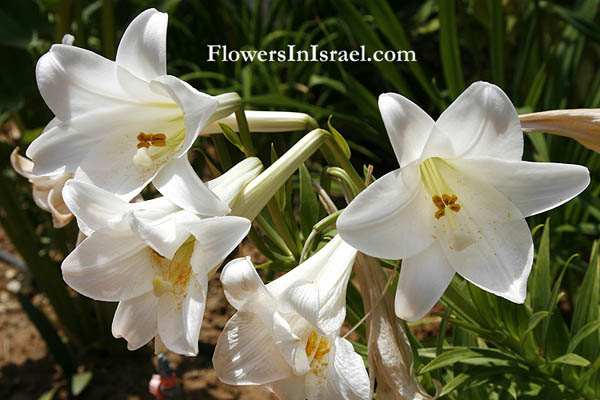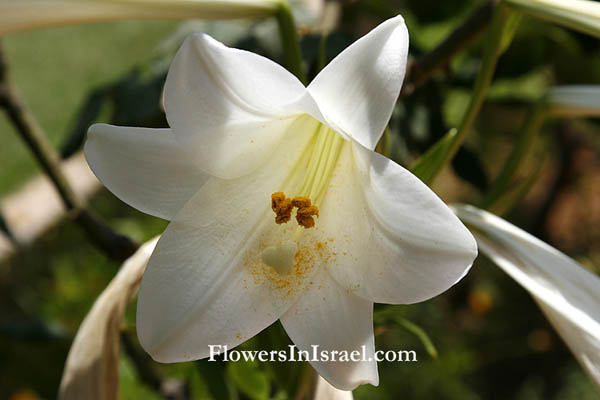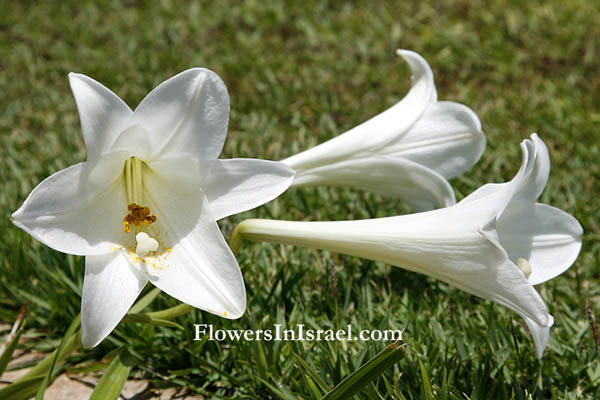Hebrew: שושן צחור, Arabic: لسوسن الأبيض
| Scientific name: | Lilium candidum L. | |
| Common name: | Madonna Lily | |
| Hebrew name: | שושן צחור | |
| Arabic name: | لسوسن الأبيض | |
| Family: | Liliaceae, שושניים |

|
| Life form: | Geopohyte | |
| Stems: | up to 120 cm highl rigid, erect, leafy | |
| Leaves: | Alternate, rosette, entire, oblong to linear-lanceolate; glabrous | |
| Inflorescence: | Up to 20 flowers in a raceme | |
| Flowers: | Hermaphrodite; trumpet-shaped, white, erect pedicles, lower ones nodding; tepals obtuse, anthers yellow; style as long as sepals | |
| Fruits / pods: | Loculicidal capsules, obovate; seldom developed; Lilium candidum is said not produce seeds in nature | |
| Flowering Period: | May, June | |
| Habitat: | Hard rock outcrops | |
| Distribution: | Mediterranean Woodlands and Shrublands | |
| Chorotype: | Mediterranean | |
| Summer shedding: | Ephemeral |

Derivation of the botanical name: Lilium, Latin li, white; +lium, flower; Greek leirion, the name applied to the eastern Mediterranean Lilium candidum. candidum, meaning shining or pure white. The Hebrew word Shoshan (shushan) from Aramaic: shoshanta, שושנתא (rose); Arabic: susin (iris); Greek: souson; translated as "lily" means beautiful flower. The word may derive from 'shesh', the root for "six", which matches the number of petals of this flower, the three outer ones known as sepals thus creating a two part, six pointed , hermaphrodite which is the source of the symbol hexagram. Hexagram is a six pointed star made up of male fiery triangle and female watery triangle representing both sexes and connection of the two triangles representing the three outer sepals and three inner petals. It is mentioned in the bible relating to King Solomon. The Hebrew word צחור, zahor, white.
"Susan" is at present the Arabic name applied to species of Iris in Israel. There are many "lily" references in the Bible like: Lilium candidum, Anemone coronaria, Hyacinthus orientalis, Iris pseudacorus, Lilium chalcedonicum, and Nymphaea alba. Lilium candidum is the lily of the dark woods and Hyacinthus orientalis is the lily of the grassy fields. The Israelites regarded the lily as the choicest among flowers and used it as a source of perfume. In ancient Hebrew poetry, the lily was always a favorite simile as a symbol of purity. The white lily is found eight times in the Song of Solomon, it is the most mentioned flower in the Bible. King Solomon (10th century BCE) referred to the lily of the valleys, shoshanat haa'maqim, in his Song of Songs 2:1. White lilies adorned the capitals of columns in many ancient civilizations, in Egypt, Assyria and Crete as well as in Salomon's Temple in Jerusalem: "The capitals at the tops of the pillars in the [Temple] vestibule were shaped like lilies and were four cubits high," declares 1 Kings 7:19. The prophet Hosea (8th century BCE) described the lily as the flower symbol of Israel: "I will be like the dew to Israel; He will blossom like the lily, and he will take root like the cedars of Lebanon...." (Hosea 14:5). From the Second Temple period (6th-1st century BCE), the lily became a popular motif in Jewish art. Both, the fleur-de-lis motif and the six-petaled star motif of the lily flower became classical. Dioscorides provides a detailed prescription of a perfume whose main ingredient is lilies and gives it the name of Susinum. SUSINON- Susinum After you have mixed together nine pounds five ounces of oil, five pounds three ounces of calamus and five ounces of myrrh] in fragrant wine, boil it, let the oil run through a strainer, pour it out again, and add three pounds six ounces of cardamom (bruised and steeped in rain water). Allow it to be sufficiently steeped together, then strain it out. Take three and a half pounds of this thickened oil and a thousand (counted) lilies, and having stripped off their leaves, put them in a broad but not deep jar. Pour in the oil, stir it around with your hands (that have been previously rubbed with honey) and let it stand for a day and a night. The next morning pour it into a cupped strainer and presently (when it is strained) separate the oil on top from the water that is strained out with it, because it will not permit the water with it, like rosaceum, but when heated together it grows hot again and is spoiled. Pour it out again into other jars smeared with honey, first sprinkling a little salt in there and taking away the filth carefully as it gathers together. Take the strained aromatic stuff out of the basket, and placing it into a broad jar pour in on it again the same amount of the aromatised oil as at first. Put in ten teaspoons of bruised cardamom, stir it well with your hands, and after waiting a little strain it out, removing the filth off from that which runs out. Pour on the oil again a third time, repeat [the procedure] throwing in the cardamom and the salt with it, and press it out (first smearing your hands with honey). That which was the first strained out will be the best, the second the next after that, and the third the least. Then take another thousand lilies and strip off theirleaves, lay them in order and pour on them the oil that was first strained out. Work methodically, doing the same things over again as you did at first, mingling cardamom [as before and afterwards straining it out]. Do the same the second and the third time, placing into it the cardamom, afterwards straining it out and repeating the procedure. As often as you steep fresh lilies in there, (by so much) you shall have the ointment stronger. Finally when it seems to you that you have enough, mix with every preparation seventy-two teaspoons of the best myrrh, ten teaspoons of crocus and seventy-five teaspoons of cinnamon. Some take the same amount of crocus and cinnamon (having pounded and sifted it), put it into a jar with water, and pour on it the ointment from the first pressing: afterwards (leaving it alone a little while) they put it into little dry jars (first smeared around with gum or myrrh and saffron and honey diluted with water). Do the very same things to the second and third pressings. Some make it with nothing else but oil balaninum or some other oil and lilies. The oil which is made in Phoenicia and in Egypt is thought to excel most, the best being that which smells [most] of lilies. Oil of lilies was produced by maceration or similar, since no fragrant essential oil can be derived from the flowers. Pliny the Elder (Pliny, Naural History XXI.126) claimed that lily boiled with oil makes hair grow on burns and John Gerard (1545-1612) recommended lily bulb ground in honey, mixed with oil or grease, for the very same problem. The lily is seen as a symbol of purity and in Christian tradition is devoted to the Virgin Mary. The archangel Gabriel is the angel of the Annunciation, in which he appears before the Virgin Mary. His attribute is a Lily held in the hand. Among female saints the lily belongs especially to Catherine of Siena (1347 - 1380), Clare of Assisi (1194 - 1253), , Euphemia (c. 307, Chalcedon, Bithynia) and Scholastica (c. 480 - 543). In pre-Christian times the lily was sacred to Juno (Hera),and sister of Jupiter, Queen of Heaven. Lilium Candidum has been the symbol of purity, chastity and virtue and was accordingly readily adopted by the Church to associate the Virgin Mary's sanctity with events of special significance. Bernard of Clairvaux (1090 – 1153), a French abbot and the primary builder of the reforming Cistercian order, wrote in the twelfth century: "Mary is the violet of humility, the lily of chastity, the rose of charity, and the glory and splendor of the Heavens. Bartholomeus Anglicus (Bartholomew of England) (born before 1203–died 1272) wrote: “The Lily is an herbe with a white flower; and though the leaves of the floure be white, yet within shineth the likeness of gold.” Bible Resources:

|